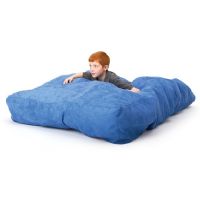 Written by Megan Smith, PT
Written by Megan Smith, PT
Living in a world abundant in sensory stimuli might make understanding the never-ending flow of information difficult. This challenge becomes even more intense for individuals, particularly children with specific conditions, turning ordinary encounters into sensory overload. Sensory Integration Therapy has emerged as a significant breakthrough for many confronting these sensory processing issues. The therapy aims to improve their sensory capacities, allowing them to comprehend better and respond to their surroundings.
Sensory Integration Therapy isn't a fleeting trend; it has a robust research foundation substantiating its effectiveness. This therapy is proven to enhance self-care skills and socialization, providing tangible improvements for those dealing with sensory issues. We invite you to visit our Multi-Sensory page to discover more about these therapeutic interventions and learning tools.
Sensory Integration Therapy, implemented in the 1970s by occupational therapist Dr. A. Jean Ayres, has been a game-changer for many, especially kids, who have difficulty making sense of the world around them. Sometimes, due to different conditions or circumstances, processing all the sensory information coming at us can get overwhelming, and that is where this therapy can help.
Sensory Integration Therapy is conducted in a structured yet playful setting, using tools like swings, balls, and brushes to create varied sensory experiences. These activities stimulate senses such as touch, balance, and body position and help to reconfigure the brain to respond appropriately to stimuli.
Customized to a child’s unique needs, the activities nudge the participant towards effective responses to sensory stimuli. This therapy aims to amplify the child’s proficiency in processing sensory inputs, paving the way for enhanced interactions with the world around them.
 | Adult Cuddle Swing - Cocoon Sensory Therapy Swing for Autism View Product |
Sensory Integration Therapy starts with a detailed assessment of the child’s environmental sensitivities. The objective is to design interventions tailored to a child's sensory challenges, aiming to aid the child in better adapting to their surroundings. Armed with this information, the therapist will devise a plan to boost touch, balance, spatial awareness, and body perception.
The child gets involved in fun, structured activities that gradually ramp up sensory experiences. This helps the child get accustomed to previously uncomfortable sensations, enabling them to react positively to stimuli that used to be bothersome. Parents or caregivers have a vital role in this process, supporting the child as they consistently practice these activities to strengthen their sensory processing abilities. Over time, this can lead to a big improvement, significantly enhancing the child's overall function and ability to interact with their environment.
 | Sensory Full Body Sock View Product |
Autism, or Autism Spectrum Disorder (ASD) is a neurodevelopmental disorder that interferes with social interaction, communication, and behavior. One distinguishing feature is the difficulty in digesting sensory information. Sensory inputs may cause overstimulation or under-stimulation in people with ASD, causing anxiety and hindering everyday tasks.
Sensory Integration Therapy effectively addresses this issue. It provides personalized, therapeutic sensory experiences, assisting people with autism in developing coping skills for sensory problems. This treatment helps the brain create stronger neural connections, which improves sensory processing. As a result, it reduces the consequences of sensory overload and under-stimulation, promoting improved environmental interactions.
| Stimulating Sensory Kit View Product |
Sensory Processing Disorder (SPD) is a disorder in which the brain has difficulties absorbing and reacting to sensory information. While it frequently co-occurs with autism, SPD can also exist independently. Individuals with SPD may over-react, under-react, or seek sensory stimulation, which can influence their everyday activities and quality of life.
Given the varying nature of SPD, the individualized approach of Sensory Integration Therapy is very useful. This treatment analyzes and targets each individual's unique sensory issues, providing personalized experiences to help the brain interpret sensory data more effectively.
 | Mounted Bubble Walls for Sensory Motor Stimulation View Product |
ADHD is characterized by persistent patterns of inattention, impulsivity, and hyperactivity that can interfere with everyday functioning and quality of life and is one of the most common neurodevelopmental disorders. People with ADHD sometimes struggle with sensory processing, resulting in conditions of both overstimulation and under-stimulation, which can aggravate their ADHD symptoms.
Sensory Integration Therapy is an important component of a complete ADHD treatment approach. This treatment assists patients with ADHD in better processing sensory inputs and managing their responses to sensory stimuli by offering personalized sensory experiences. This can result in increased concentration, less impulsivity, and an overall improvement in their ability to engage in daily activities.
 | Cloud Nine Cushions for Multi Sensory Crash Pits View Product |
Post-Traumatic Stress Disorder (PTSD) is a mental health illness that can develop when a traumatic event is experienced or observed. PTSD frequently presents as flashbacks, nightmares, intense anxiety, and uncontrolled thoughts about the incident. Individuals suffering from PTSD are also prone to developing sensory sensitivities, in which specific noises, images, or textures may elicit a traumatic memory, causing distress.
Sensory Integration Therapy can be quite beneficial in resolving the sensory difficulties linked with PTSD. This therapy can help patients reset their reactions to triggering sensory cues by introducing personalized sensory experiences in a gradual, controlled manner. They can learn to control their sensory sensitivities more efficiently over time, which can help with PTSD symptoms and overall healing and recovery.
 | Adjustable Weighted Blanket View Product |
Language and learning disabilities are a group of disorders that affect a person's ability to interpret either what they see and hear or to link information from different parts of the brain. These limitations can present themselves in various ways, including issues with spoken and written language, coordination, self-control, or concentration. Sensory processing difficulties, particularly with touch or visual stimuli, frequently accompany these disorders.
Sensory Integration Therapy can be very effective for people with language and learning impairments. It helps them process and respond to sensory information, particularly tactile and visual inputs. Individuals can better engage with their learning settings and absorb information more effectively.
| Switch Adapted Aqua Dome Multisensory Therapeutic Learning Toy View Product |
Finding clarity in a world overflowing with sensory input may be difficult for many people. Sensory Integration Therapy is critical for persons dealing with these difficulties. This therapy successfully assists patients in recalibrating their sensory responses, opening the way for more effective interactions with their environment.
As you continue to delve into the world of sensory treatments, our Multi-Sensory category offers a plethora of information and products using various therapeutic methods and learning aids. Consider exploring more topics and information by visiting us at Caregiver University. Remember that a well-informed and supportive environment may significantly impact the lives of those with sensory problems.

Megan has been a part of Rehabmart since its inception nearly 20 years ago. For the past several years she has been enjoying her role as HR Director while maintaining her Physical Therapy license. When she isn't working on her next in-service or working to find a new team member, she enjoys her five children, helping those who have PT type ailments, baking, practicing yoga, and working out.